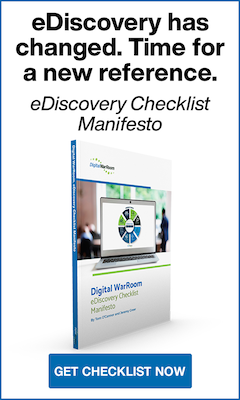Preparing privilege logs can be one of the most time-consuming and difficult tasks in civil and commercial litigation. It can result in large document productions that can be a nightmare to manage.
However, this unwieldy process is important. A deficient privilege log can result in severe consequences. For example, leading to time-consuming discovery disputes or a waiver of privilege. A complete privilege log can make or break a case.
Federal law generally requires a party to create a privilege log if they are withholding responsive information from a discovery production on the basis of claiming privilege. Most civil litigation and even criminal litigation follow the construct for discovery codified in the Federal Rules of Civil Procedure (FRCP).
Thus, a privilege log is a document that lists the documents and materials that have been withheld from production in response to a discovery request. The purpose of the privilege log is to provide an itemized list of each document that has been claimed as privileged, along with information about why the privilege applies.
To help with this tedious endeavor, Digital WarRoom empowers law firms and legal professionals with how to create a privilege log using our user-friendly eDiscovery software.
What is a Privilege Log?
A privilege log is a document that lists the documents and materials that have been withheld from production in response to a discovery request. The purpose of the privilege log is to provide an itemized list of each document that has been claimed as privileged from the opposing party, along with information about why the privilege applies.
In order to create a valid privilege log, you must be able to identify the document or material that is being withheld, and you must be able to explain why the privilege applies.
For example, if you are withholding a document because it is protected by attorney-client privilege, you would need to identify the document and explain how it meets the requirements for attorney-client privileged communication.
Privilege Log: Federal Rules
There are two main types of privilege logs: those that follow federal rules and those that follow state rules.
Federal Rule of Evidence 502 governs the use of privilege logs in federal court.
Under this rule, a party who withholds information on the basis of privilege must provide “a description of the nature of the documents, communications, or things not produced or disclosed—and do so in a manner that, without revealing information itself privileged or protected from disclosure, will enable other parties to assess the claim.”
Thus, while it is a lawyer's duty to protect their client's privileged information (such as communications documenting attorney advice), they must properly note this information during the production phase.
However, while creating multiple document productions, it can be difficult to accurately sort and tag privileged information by hand. That's why eDiscovery software for creating privilege log federal rules logs during document review is so useful.
Privilege Log: Example
An example of a federal privilege log is provided below:
Document Number: 1234
Description: Email between attorney John Smith and client Jane Doe regarding potential legal action against XYZ Corporation.
Date: January 15, 2018
Privilege: Attorney-Client Privilege
Reason: The email is protected by attorney-client privilege because it contains confidential communications between an attorney and client.
All of the fields listed below will populate automatically, showing the auditable nature of performing privilege review within an eDiscovery software platform like Digital WarRoom:
- Beg Bates
- End Bates
- Mark Reviewer (Login ID)
- Marked on (Date)
- Privilege Reviewer (Login ID)
- Privilege Entry (Date)
- Comment (Created during review)
- Family # (A unique ID number representing a document family. Ex: document and attachment)
- Rank #
- Pith # (A unique ID number representing a set of near-duplicate documents) (see deduping article for explanation)
- Doc Title (Or subject line for email)
- Extension
- Locus
- Custodian (The owner of a particular document collection, assigned during review)
How to Create a Privilege Log Entry
Within Digital WarRoom software, the privilege log function becomes available after you mark a document as privileged.
Now that we have reviewed the basics of privilege logs, let’s discuss how to create a privilege log entry using Digital WarRoom eDiscovery software.
The software assumes that every document marked as privilege will require a privilege log entry. Digital WarRoom has a tool called the "Work Product Inspector," which is perfect for marking documents and supports on-the-go creation of the corresponding privilege log entries.
To begin the workflow, simply mark a document as privileged within the work product inspector and tab over to “Privileged Metadata” to fill out the corresponding privilege log entry.
As mentioned, available pieces of metadata such as Author, To, From, and CC should populate automatically within the privilege log. Now is the time to validate that data and assign a privilege type and privilege reason.
Digital WarRoom has a set of eleven default privilege reasons:
- Attorney requested legal assistance
- Attorney providing advice
- Subordinate provided legal assistance
- Agent provided information to subordinate
- Subordinate requested information
- Attorney provided client legal advice
- Securing legal advice
- Subordinate related legal advice
- Notes of attorney
- Word product draft
- Work product notes
If you were to choose the reason “Attorney requested legal assistance,” you would see the Comment Box populate with information that you need to complete.
For example, the comment for the document description could be, "confidential communication between attorney and attorney subordinate where attorney requested legal assistance from subordinate so that attorney could provide client legal advice and legal services with respect to <BLANK>."
Using Digital WarRoom eDiscovery Software for Privilege Logs
Digital WarRoom eDiscovery software is the perfect tool for creating and managing privilege logs. With Digital WarRoom, you can easily upload your documents, create new privilege log entries, and share your privilege logs with other parties.
A good "priv log" best practice is to review each document once to assess it properly. If privileged, apply the appropriate mark and fill out the privilege log entry immediately.
However, this discovery process is not always followed due to various factors. Digital WarRoom has guardrails set to assist in maintaining the integrity of your privilege review.
For example, Digital WarRoom does not allow you to bulk assign privilege type or privilege reason. This needs to be done manually for each privileged document.
To learn more about how to use Digital WarRoom for your next case and privileged documents log, contact us today. Digital WarRoom support staff would be happy to answer any questions you have about Digital WarRoom's platform or provide you with a free demo.
-1.png?width=400&height=164&name=DWRLogoClassic%20-%20Copy%20(2)-1.png)









Comment On This Article